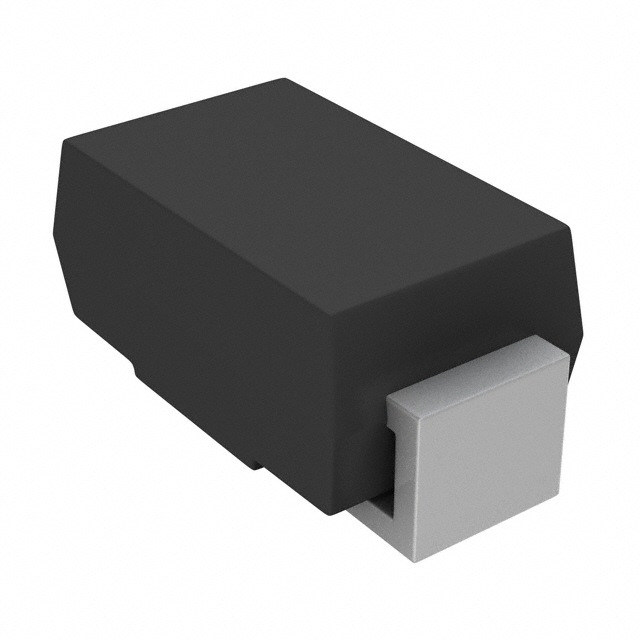P4SMA150A-E3/61
Introduction
The P4SMA150A-E3/61 is a diode belonging to the category of transient voltage suppressors (TVS). This entry provides an overview of the basic information, specifications, detailed pin configuration, functional features, advantages and disadvantages, working principles, detailed application field plans, and alternative models of the P4SMA150A-E3/61.
Basic Information Overview
- Category: Transient Voltage Suppressor Diode
- Use: Protecting sensitive electronic devices from voltage transients induced by lightning, inductive load switching, and electrostatic discharge.
- Characteristics: Fast response time, low clamping voltage, high surge current capability.
- Package: DO-214AC (SMA), SMC package.
- Essence: Provides overvoltage protection to electronic circuits.
- Packaging/Quantity: Available in tape and reel packaging, with quantities varying based on supplier and order size.
Specifications
- Peak Pulse Power: 400W
- Breakdown Voltage: 150V
- Operating Voltage: 128V
- Maximum Clamping Voltage: 207V
- Peak Pulse Current: 14.5A
- Operating Temperature Range: -55°C to +150°C
Detailed Pin Configuration
The P4SMA150A-E3/61 has two pins, with the anode connected to one end and the cathode connected to the other end. The pinout follows the standard configuration for SMA and SMC packages.
Functional Features
- Transient Voltage Suppression: Rapidly clamps transient voltages to safe levels.
- Low Clamping Voltage: Provides effective protection for sensitive electronics.
- Fast Response Time: Reacts quickly to transient events, minimizing potential damage.
Advantages and Disadvantages
Advantages
- Effective protection against voltage transients.
- Low clamping voltage ensures minimal stress on protected circuits.
- Fast response time reduces the risk of damage to sensitive components.
Disadvantages
- Limited to specific voltage ranges.
- May require additional circuitry for comprehensive overvoltage protection.
Working Principles
The P4SMA150A-E3/61 operates by diverting excess transient current away from sensitive components when a voltage surge occurs. It achieves this through rapid conduction and clamping of the transient voltage to a safe level, thereby protecting downstream electronics.
Detailed Application Field Plans
The P4SMA150A-E3/61 is commonly used in various applications, including: - Telecommunication equipment - Industrial control systems - Automotive electronics - Consumer electronics - Power supplies
Detailed and Complete Alternative Models
Alternative Model 1: P6SMB150A
- Breakdown Voltage: 150V
- Package: DO-214AA (SMB)
- Peak Pulse Power: 600W
Alternative Model 2: 1.5SMC150CA
- Breakdown Voltage: 150V
- Package: DO-214AB (SMC)
- Peak Pulse Power: 1500W
Alternative Model 3: SMBJ150A
- Breakdown Voltage: 150V
- Package: DO-214AA (SMB)
- Peak Pulse Power: 600W
In conclusion, the P4SMA150A-E3/61 is a vital component in safeguarding electronic circuits from voltage transients, offering fast response times and low clamping voltages. Its application spans across various industries, and it has several alternative models with similar functionalities.
Word Count: 470
Lista 10 Vanliga frågor och svar relaterade till tillämpningen av P4SMA150A-E3/61 i tekniska lösningar
What is the maximum peak pulse power of P4SMA150A-E3/61?
- The maximum peak pulse power is 400 watts for a 10/1000 µs waveform.
What is the breakdown voltage of P4SMA150A-E3/61?
- The breakdown voltage is 128V to 142V at 1mA.
What is the typical clamping voltage of P4SMA150A-E3/61?
- The typical clamping voltage is 205V at 30A.
What are the applications of P4SMA150A-E3/61?
- It is commonly used in surge protection for sensitive electronics, such as telecommunications equipment, industrial control systems, and automotive electronics.
What is the operating temperature range of P4SMA150A-E3/61?
- The operating temperature range is -55°C to +150°C.
Does P4SMA150A-E3/61 meet RoHS requirements?
- Yes, it is compliant with RoHS requirements.
What is the package type of P4SMA150A-E3/61?
- It comes in a DO-214AC (SMA) package.
Is P4SMA150A-E3/61 suitable for high-speed data line protection?
- Yes, it is suitable for high-speed data line protection due to its fast response time.
Can P4SMA150A-E3/61 be used for ESD protection?
- Yes, it can be used for ESD protection in various electronic devices.
What are the key features of P4SMA150A-E3/61?
- Some key features include low incremental surge resistance, excellent clamping capability, and fast response time.


